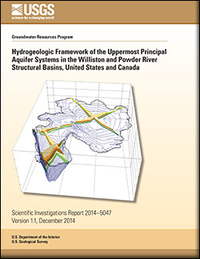Hydrogeologic framework of the uppermost principal aquifer systems in the Williston and Powder River structural basins, United States and Canada
Links
- More information: USGS Index Page
- Document: Report (11.9 MB pdf)
- Appendix: Appendix
- Companion File: Downloads Directory
- Download citation as: RIS | Dublin Core
Abstract
The glacial, lower Tertiary, and Upper Cretaceous aquifer systems in the Williston and Powder River structural basins within the United States and Canada are the uppermost principal aquifer systems and most accessible sources of groundwater for these energy-producing basins. The glacial aquifer system covers the northeastern part of the Williston structural basin. The lower Tertiary and Upper Cretaceous aquifer systems are present in about 91,300 square miles (mi2) of the Williston structural basin and about 25,500 mi2 of the Powder River structural basin. Directly under these aquifer systems are 800 to more than 3,000 feet (ft) of relatively impermeable marine shale that serves as a basal confining unit. The aquifer systems in the Williston structural basin have a shallow (less than 2,900 ft deep), wide, and generally symmetrical bowl shape. The aquifer systems in the Powder River structural basin have a very deep (as much as 8,500 ft deep), narrow, and asymmetrical shape.
The Williston structural basin has been an important oil and natural gas producing region since the 1950s, and production has increased substantially since the mid-2000s due to improved drilling and hydraulic fracturing methods from deep formations, such as the Bakken and Three Forks Formations. These improved methods require considerable volumes of freshwater mostly from shallow aquifers or surface water. Coal, lignite, and coal-bed natural gas are additional sources of energy in both basins that can affect the quality and quantity of shallow aquifers through strip mining and groundwater depletion.
In 2011, the U.S. Geological Survey initiated a regional study of the glacial, lower Tertiary, and Upper Cretaceous aquifer systems in the Williston and Powder River structural basins with the goal to quantify groundwater availability. This report, together with a companion report of the conceptual flow model, provides an improved understanding of the groundwater flow systems and a basis for a numerical, regional groundwater-flow model.
This study combines the lithostratigraphic units of the glacial, lower Tertiary, and Upper Cretaceous aquifer systems in the United States and Canada into 7 regional hydrogeologic units—glacial deposits, 4 bedrock aquifers, and 2 bedrock confining units—using general hydraulic properties. The glacial deposits are composed of till and glacial outwash sands and gravels with areas of cobbles and boulders. The four bedrock aquifers are the upper Fort Union, lower Fort Union, lower Hell Creek, and Fox Hills aquifers and are contained primarily in sandstone layers. The two confining units are the middle Fort Union hydrogeologic unit (shale) and upper Hell Creek hydrogeologic unit (contains less sandstone than the underlying lower Hell Creek aquifer). Water from hydrogeologic units in these three aquifer systems is relatively fresh and potable, whereas withdrawals seldom occur from units below the basal confining unit because of great depths (greater than 800 ft) and poor water quality.
Analysis of about 300 electric (resistivity) and lithologic logs in the Williston structural basin and numerous existing publications for the Powder River structural basin were used to develop a three-dimensional hydrogeologic framework for both basins. Interpolated thicknesses of the glacial deposits, the lower Tertiary aquifer system, and the Upper Cretaceous aquifer system in the Williston structural basin are less than about 750; 2,250; and 1,050 ft, respectively. Interpolated thicknesses of the lower Tertiary aquifer system and the Upper Cretaceous aquifer system in the Powder River structural basin are less than about 7,180 and 5,070 ft, respectively. Interpolated horizontal hydraulic conductivity values for the Williston structural basin were as much as 25 feet per day (ft/d) in the glacial deposits and had smaller ranges in the lower Tertiary aquifer system (0.01–9.8 ft/d) and in the Upper Cretaceous aquifer system (0.06–5.5 ft/d). In the Powder River structural basin, the lower Tertiary aquifer system had a greater range of interpolated horizontal hydraulic conductivity values (0.10–11 ft/d) than the Upper Cretaceous aquifer system (0.02–5.7 ft/d). Transmissivity is greatest in the gravel zones of the glacial deposits (2,120 feet squared per day) and generally decreases with depth into the bedrock units.
Regionally, water in the lower Tertiary and Upper Cretaceous aquifer systems flows in a northerly or northeasterly direction from the Powder River structural basin to the Williston structural basin. Groundwater flow in the Williston structural basin generally is easterly or northeasterly. Flow in the uppermost hydrogeologic units generally is more local and controlled by topography where unglaciated in the Williston structural basin than is flow in the glaciated part and in underlying aquifers. Groundwater flow in the Powder River structural basin generally is northerly with local variations greatest in the uppermost aquifers. Groundwater is confined, and flow is regional in the underlying aquifers.
Study Area
| Publication type | Report |
|---|---|
| Publication Subtype | USGS Numbered Series |
| Title | Hydrogeologic framework of the uppermost principal aquifer systems in the Williston and Powder River structural basins, United States and Canada |
| Series title | Scientific Investigations Report |
| Series number | 2014-5047 |
| DOI | 10.3133/sir20145047 |
| Edition | Version 1: Originally posted June 17, 2014; Version 1.1: December 1, 2014 |
| Year Published | 2014 |
| Language | English |
| Publisher | U.S. Geological Survey |
| Publisher location | Reston, VA |
| Contributing office(s) | Wyoming-Montana Water Science Center |
| Description | Report: viii, 38 p.; Appendix figures and tables; Downloads Directory |
| Country | Canada;United States |
| Other Geospatial | Powder River Basin;Williston Basin |
| Datum | North American Datum 1983 |
| Projection | North American Lambert Conformal Conic projection |
| Online Only (Y/N) | Y |
| Additional Online Files (Y/N) | Y |


